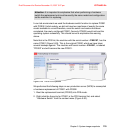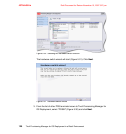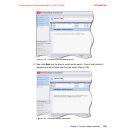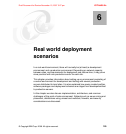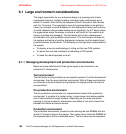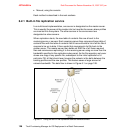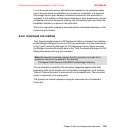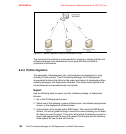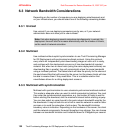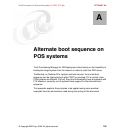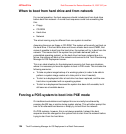Chapter 6. Real world deployment scenarios 127
Draft Document for Review November 15, 2007 3:27 pm 4372ch06.fm
the different warehouse and store locations that the master sychronizes with to
allow for distribution of images across the enterprise.
6.1.2 Expanding from one to multiple servers
The general architecture for Tivoli Provisioning Manager for OS Deployment is a
two-tiered architecture consisting of a Tivoli Provisioning Manager for OS
Deployment master server and multiple clients slaves that synchronize with the
data on the master. There are two primary methods for expanding the Tivoli
Provisioning Manager for OS Deployment architecture from a single server to
mulitple servers. The first approach is to have a single instance of the database
which all masters and slave Tivoli Provisioning Manager for OS Deployment
servers connect to via ODBC or JDBC. The second approach is to utilize the
netclnt command on each slave server to synchronize with the master server.
In the first approach, a central multiuser database like DB2® is created on a
server that the master and slave Tivoli Provisioning Manager for OS Deployment
servers have access to. Once the database server is setup then an ODBC/JDBC
connection is configured prior to installation of the Tivoli Provisioning Manager
for OS Deployment product is installed, using the same name that would
normally be created during installation. Once the ODBC/JDBC connection is
created on each server that will be either a master or a slave then install the
server product. Once the product is installed go into the server → server
parameters → server synchronization panel to assign the roles of master and
slave to each Tivoli Provisioning Manager for OS Deployment server.
In the second approach, each Tivoli Provisioning Manager for OS Deployment
server is installed as a standalone server with an independent database. In order
for the slaves to synchronize their data with the master the netclnt command
must be scheduled on each slave which establishes a connection to the master’s
database. In this scenario, the relationship between master and slave are not
visualized in the GUI as in the first approach.
In both scenarios, a Tivoli Provisioning Manager for OS Deployment server can
be both a master and a slave depending on how they are configured.
6.2 Replicating software and configurations
There are three methods you can use to replicate images between Tivoli
Provisioning Manager for OS Deployment servers:
Automated, using built-in replication service between two servers
Manual, using the command line tool



